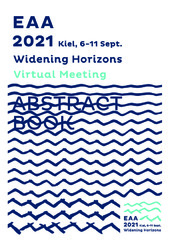Приказ основних података о документу
Lithic and osseous industries in the Late Neolithic: mutual relations and interconnections
| dc.creator | Vitezović, Selena | |
| dc.creator | Antonović, Dragana | |
| dc.creator | Dimić, Vidan | |
| dc.date.accessioned | 2023-11-23T10:20:27Z | |
| dc.date.available | 2023-11-23T10:20:27Z | |
| dc.date.issued | 2021 | |
| dc.identifier.isbn | 978-80-907270-8-3 | |
| dc.identifier.uri | http://rai.ai.ac.rs/handle/123456789/808 | |
| dc.description.abstract | Lithic and osseous industries represent very important technologies among Neolithic communities; they were principal raw materials for production of everyday tools, used also for decorative and other non-utilitarian objects. However, current archaeological practice in majority of projects is to sort portable finds according to their raw material and to study them separately, and this is why wider studies of technological systems are very rare. In this paper, we will explore mutual relations and connections of the ground and abrasive stone and osseous technologies within the Late Neolithic Vinča culture in the central Balkan area (with particular focus on the assemblages from the sites of Vinča-Belo Brdo and Pločnik). Ground and abrasive stone tools were used for production of osseous artefacts; in fact, the abundance of abrasive stone tools is closely linked with the osseous technology, since abrasion was widely used technique for manufacturing and especially for repair of osseous tools. Osseous raw materials were, in turn, used for production of handles and hafts for stone axes, adzes, chisels, etc. There are multiple other aspects of mutual connection and inter-dependence: tool kits for certain activities and craft include both lithic and bone tools for diverse stages of production (for example, woodworking); there are cases of skeuomorphism – morphologically identical or similar artefacts produced from both lithic and osseous tools, such as small chisels, axes, etc. Tight connections between these two technologies show that traditions and innovations in one technology cannot be understood without the studies of the other, and that studies of technological systems are very much needed for comprehensive studies of prehistoric economy and craft production. | sr |
| dc.language.iso | en | sr |
| dc.publisher | Prague : European Association of Archaeologists | sr |
| dc.rights | openAccess | sr |
| dc.source | Widening horizons EAA 2021 Kiel, 6-11 Sept. : virtual meeting : abstract book | sr |
| dc.subject | Lithic and osseous industries | sr |
| dc.subject | Neolithic | sr |
| dc.subject | Late Neolithic | sr |
| dc.subject | Vinča culture | sr |
| dc.subject | Stone tools | sr |
| dc.subject | Bone tools | sr |
| dc.subject | technological system | sr |
| dc.title | Lithic and osseous industries in the Late Neolithic: mutual relations and interconnections | sr |
| dc.type | conferenceObject | sr |
| dc.rights.license | ARR | sr |
| dc.rights.holder | sr | |
| dc.citation.epage | 851 | |
| dc.citation.spage | 850 | |
| dc.description.other | Abstract Book of 27th EAA Annual Meeting (Kiel Virtual, 06-11. 09. 2021), Kiel, Germany (pp. 850-851). Prague : European Association of Archaeologists. | sr |
| dc.identifier.fulltext | http://rai.ai.ac.rs/bitstream/id/1841/bitstream_1841.pdf | |
| dc.identifier.rcub | https://hdl.handle.net/21.15107/rcub_rai_808 | |
| dc.type.version | publishedVersion | sr |


